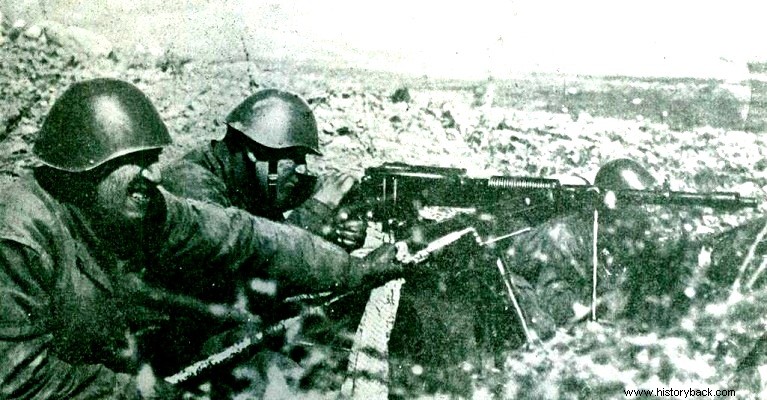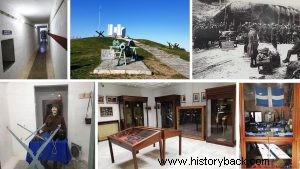
The historical memory and the greatness of the Greek soul are revived in the mind and eyes of every visitor who sets foot in the sacred area of the Rupel forts. There, on the verdant slope of Rupel, where history and the natural environment coexist harmoniously, under the shadow of the marble monument of the fallen soldiers, officers, non-commissioned officers and enlisted men, the human mind cannot help but contemplate the supreme sacrifice of the Greeks towards the Nazi troops.
At an altitude of 1339 meters, the view gazes unobstructed over most of the Greek-Bulgarian border, along Mount Agistro, near the Strymonas River. There, everything is pure, clear, almost sacred, bathed in sunlight. As pure and holy was the struggle of the defenders of the fort eighty years ago, in the famous "Battle of the Forts", along the so-called "Metaxa Line".
By visiting Roupel, you don't just get to know a great moment in modern Greek history. You admire up close the works of the people who defined a historical reality. You admire the struggles fought by young and old soldiers, named and anonymous officers, in order to keep values and ideals alive, but above all to preserve the freedom of the homeland.
The mountain hides in its bowels a historical museum
The access to the fortress, easy and fast from the large highway, part of Egnatia (vertical axis A25) that leads to the Greek-Bulgarian border and to the customs office of Promachona. Entrance to the fort is free however it always remains a guarded military area. Of course, in recent months, due to the coronavirus pandemic and the strict health protocols in force, all visits and guided tours of its facilities have been suspended until further notice.
In any case, however, and under normal circumstances, visitors must hand in their ID at the entrance and it will be returned to them upon departure from the military compound. At the end of the route there is an organized parking area for cars and buses. The road is paved along its entire length.
As the visitor climbs the hill of the Rupel fort, he cannot remain indifferent in front of the majesty of nature. In Autumn and Winter, the morning dew forms a dense cloud that can block visibility in the surrounding areas, but at the same time gives the unique feeling of being above the clouds. In the Spring and Summer, nature reveals itself majestically, reminding us that in this splendor, eighty years ago dozens of soldiers from both sides lost their lives.
The courtesy, the friendly disposition, the warm smile of the soldiers who welcome the visitors to the military complex of the fort predispose to a very interesting experience. At the same time, the formality followed by the military personnel suggests to the visitors that they are in a sacred space, full of symbolism and messages. A place that every Greek and foreigner must respect, paying minimal tribute to the defenders of the fort.
A coffee in the forts' KPSM and a short break before the tour prepares the visitor to become part of all those great and important that took place up and down the mountain slopes during the three-day "Battle of the Forts", where the Nazi forces they were literally pounding the Greek troops.
The congratulations of the Germans to the defenders of the fort
The 10th of April 1941, a decisive date not only for the fate of the forts but also for Greece, is captured photographically and dominates the entrance to the central portico, where the guided tour begins and ends. It is the day of the surrender of the forts by their commander, lieutenant colonel Georgios Duratsos, to the German invaders demanding at the same time that "no German should climb the fort until the last ones leave", as it happened. There had been a three-day hard-fought battle throughout the "Battle of the Forts" along the "Metaxa Line" between the Greek and German soldiers, where it may have ended with the victory of the latter, but their losses were almost double from those of the Greeks.
The German colonel who took over the fort congratulated the commander, expressing his admiration and appreciation for the resistance and heroism of the Greek soldiers. He even emphasized that it was an honor and pride for the Germans to have such a heroic army as their opponent. A German section was lined up outside the fort and paid tribute. Then officers and soldiers left on foot for Sidirokastro and Serres.
“Fortresses are not surrendered. They are occupied'
The historical words of Lt. Col. Duratsos - "Fortresses are not surrendered. Occupied"- are located at the entrance of the portico attributing the magnitude of the heroism of the Greek soldiers. The intense bombardment by the Germans had not dampened the morale of the defenders of the forts.
It should be noted that there were only 27 officers and 950 hoplites in the Rupel fort. Around the fort there were only eight cannons, divided between the artillery of Captain Kozonis and the hero Lieutenant Kyriakides, in well-hidden positions. The German military forces were armored with equipment that was numerically and technologically superior to the Greeks.
At 14 dead and 38 wounded, the number of losses of the Rupel fortress in the total of four days that lasted the bombardment of the German troops. The forts were never captured thanks to the heroism of the Greek defenders, who until the last moment fought with self-sacrifice. They were surrendered when the administration of the forts had already been informed of the capitulation of Greece to the Germans.
The few objects of the soldiers and a Greek flag with the royal crown that are kept at the entrance of the portico of the administration fort are only small nuggets of the great but difficult moments that the Greek soldiers lived in their daily life defending the fort and the homeland. The tour of the fort arcade, really moving, almost immersive. The gallery is an excellent example of engineering, perfect organization, ingenuity, foresight and above all faith in the survival and defense of the homeland. And all this under very difficult conditions, political, mainly economic but also social.
The self-sacrifice of Captain Kyriakides
One of the most important moments of the tour is the visit to the military museum of the forts. Inside it are displayed uniforms, flags, weapons of the Greek and German armies during the Second World War as well as one of the two anti-tank guns that the fortress guard had in 1941. A special place among the exhibits is occupied by the personal belongings of Captain Alexandros Kyriakides and his soldiers, as found in the trench with their bones in 2001, sixty years after their heroic death and self-sacrifice in 1941.
Captain Kyriakidis refused to cease his artillery fire and thus became the target of the German Stukas. Together with his soldiers he met a tragic death in the position where the artillery shelter was. In April 2001, on the initiative of officer Ilias Kotridis, the investigation began to find the bones of the fallen artillerymen of Captain Kyriakides.
Fort Rupel was never captured due to the unparalleled resistance of the fighters and its durable construction. For eighty years now it remains there, proud on the mountain and as if it too has a soul, it gives its own testimony about the unequal but honorable struggle of the Greek soldiers and their defense for the defense and freedom of the homeland. Only in Rupel can the visitor mentally listen to the heartbeat of its defenders, walking on its "powdered" slopes and underground labyrinthine arcades.

APE-BE, V. LIOLIDIS
